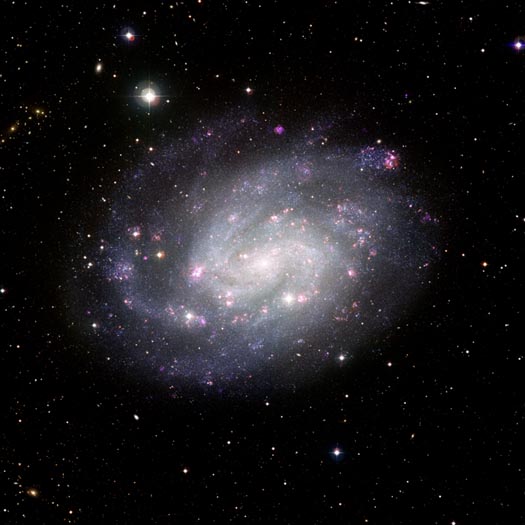
of the Southern Spiral NGC 300
Spiral Galaxy
RA: 0h 54m 53.49s Dec: -37° 41' 3.25"
Sculptor
6 million light years
30.22 x 30.22 arcminutes
North is 0.1° left of vertical
ESO
September 8, 2010
2004 image: G0407
ABOUT THIS IMAGE:
ESO has released a spectacular new image of NGC 300, a spiral galaxy similar to the Milky Way, and located in the nearby Sculptor Group of galaxies. Taken with the Wide Field Imager (WFI) at ESO's La Silla Observatory in Chile, this 50-hour exposure reveals the structure of the galaxy in exquisite detail. NGC 300 lies about six million light-years away and appears to be about two thirds the size of the full Moon on the sky.
Originally discovered from Australia by the Scottish astronomer James Dunlop early in the nineteenth century, NGC 300 is one of the closest and most prominent spiral galaxies in the southern skies and is bright enough to be seen easily in binoculars. It lies in the inconspicuous constellation of Sculptor, which has few bright stars, but is home to a collection of nearby galaxies that form the Sculptor Group [1]. Many galaxies have at least some slight peculiarity, but NGC 300 seems to be remarkably normal. This makes it an ideal specimen for astronomers studying the structure and content of spiral galaxies such as our own.
This picture was assembled from many individual images taken through a large set of different filters with a total exposure time close to 50 hours. The data was acquired over many observing nights, spanning several years. The main purpose of this extensive observational campaign was to take an unusually thorough census of the stars in the galaxy, counting both the number and varieties of the stars, and marking regions, or even individual stars, that warrant deeper and more focussed investigation. But such a rich data collection will also have many other uses for years to come. By observing the galaxy with filters that isolate the light coming specifically from hydrogen and oxygen, the many star-forming regions along NGC 300's spiral arms are shown with particular clarity in this image as red and pink clouds. With its huge field of view, 34 x 34 arcminutes, similar to the apparent size of the full Moon in the sky, the WFI is an ideal tool for astronomers to study large objects such as NGC 300.
NGC
300 is also the home of many interesting astronomical phenomena that have
been studied with ESO telescopes. ESO astronomers recently discovered
the most distant and one of the most massive stellar-mass black holes
yet found in this galaxy, as the partner of a hot and luminous Wolf-Rayet
star in a binary system. NGC 300 and another galaxy, NGC 55, are slowly
spinning around and towards each other, in the early stages of a lengthy
merging process. The current best estimate of the distance to the NCG
300 was also determined by astronomers using ESO's Very Large Telescope
at the Paranal Observatory, among others.
Notes
[1]
Although it is normally considered as member of the Sculptor Group, the
most recent distance measurements show that NGC 300 lies significantly
closer to us than many of the other galaxies in the group and may be only
loosely associated with them.